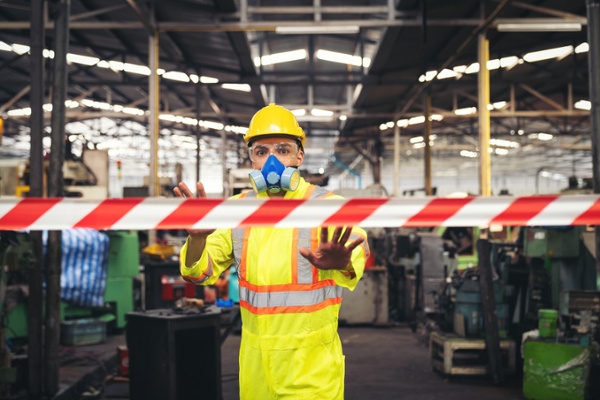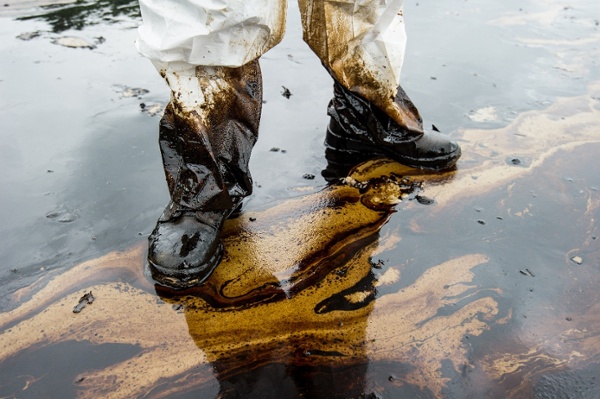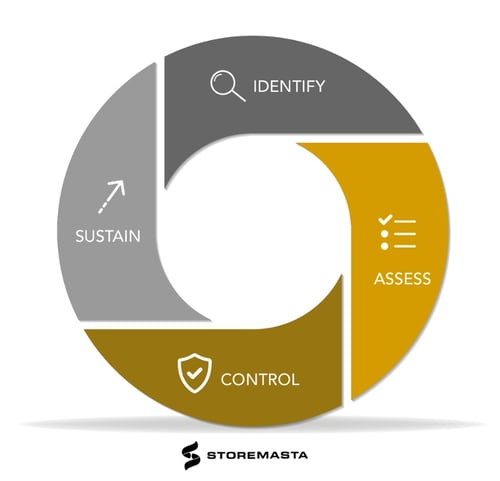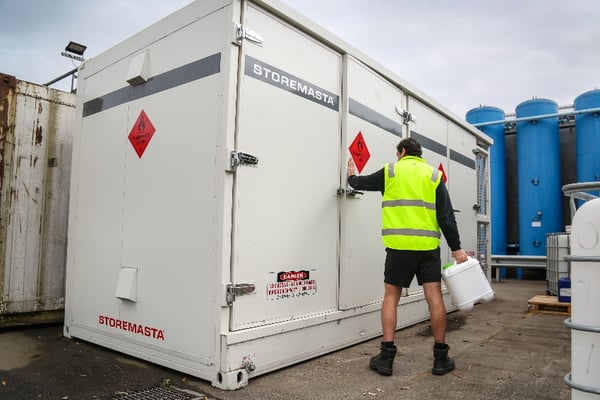Chemicals have undoubtedly improved industrial processes, allowing for workplaces to improve and innovate in ways that would have otherwise been impossible. However, many common workplace chemicals have dangerous properties — including being flammable, corrosive, oxidising or toxic. These hazardous chemicals can create a range of workplace and environmental hazards that must be managed and controlled to ensure health and safety. This post is all about chemical hazards: what they are and how we can minimise their potential for harm.
What Are Chemical Hazards?
A chemical hazard is simply the risks involved with using a harmful chemical. Chemical hazards fall into two key categories, which are:
Health Hazards
Where workers and other personnel are exposed to hazardous chemicals through inhalation, absorption through the skin, or ingestion and swallowing.
Chemical health hazards can be acute (nausea, vomiting, acid burns, asphyxiation — which happen immediately) or chronic (dermatitis, asthma, liver damage, cancer — which develop after prolonged exposure).

Chemicals can harm staff members who are exposed to them, with either short or long-term health consequences.
Physiochemical Hazards
Where workers, the workplace itself, AND the environment can all be damaged or harmed because of the physical nature of the chemical.
These physiochemical hazards surround a chemical’s physical attributes (think flammables, explosives, corrosives, self-reactive) and the way they are handled and stored.
REMEMBER: Chemicals come in many forms – with various chemical and physical properties that may cause harm. Hazardous chemicals are not just liquids such as acetone, peroxide, butane or petrol; they may be compressed gases (ammonia, chlorine, methane) or solids (lye, cement mix, asbestos).
Examples Of Common Chemical Hazards
There are many examples of chemical hazards that you may find in your work workplace. We'll go through some of these in the following section of our post.

Chemical hazards in the workplace may create incidents that can harm people, property and the environment and halt operations. It's vital that chemical hazards are identified and control to prevent this occurring.
Fires
Many hazardous chemicals have flammable or combustible properties, which can quickly cause a serious fire or explosion. Chemical fires can occur if ignition sources are in areas where flammable substances are being handled or stored. They may also occur if there is an incompatibility between substances.
Incorrect handling and unsafe work practices can also lead to chemical fires. Due to the fact that flammable and explosive chemicals are often contained in large cylinders or drums, it’s essential to train everyone handling the chemicals – including warehouse staff and forklift drivers - to take care when receiving and moving chemicals about the workplace. When some hazardous chemicals aren’t stored or handled in the correct way, they can create a fire or explosion risk that can damage people, property and the environment.
REMEMBER: Chemicals often have both health hazards as well as physiochemical hazards. For example, if a cylinder of a hazardous chemical is accidentally severed (then catches fire and explodes) workers and emergency responders may have to deal with the health hazards associated with exposure to the chemical as well as the fire.
Chemical Reactions
Many chemicals react violently when they contact other substances and must be used and stored very carefully. Reactions can occur just from exposure to heat, sunlight, and water.
Chemical hazards also exist in the way certain chemicals are mixed. Sometime the order in which a substance is introduced to a mix or even the speed at which it is added (think mixing a solvent) can create a dangerous reaction.
An extension of a chemical hazard is when staff don’t understand the nature of the chemicals they use or what to do in an emergency. A tragic example of this occurred in Ireland where two chemists were mixing chemicals and made an error in the process. Realising the mistake, the chemists ran out of the control room to shut down the experiment but ran into the explosion. One worker was killed.
REMEMBER: Controlling chemical hazards involves a range of controls including the development of safe operating procedures. Staff must also be trained to fully understand the nature of all the chemicals they handle, how to use them, and know what to do in an emergency.
Environmental Hazards
Many chemicals are hazardous to the environment. This can be in the form of gas and heat emissions released into the air; toxins seeping into landfill and waterways; or damage caused by fires, explosions and chemical reactions which spread outside the worksite.

Environmental hazards occur when hazardous chemicals are released into the environment, often through dirt, drainage systems or incorrect waste disposal.
Many of the health hazards that effect humans also affect plants, wildlife and microorganisms, often damaging or destroying entire ecosystems.
REMEMBER: Your WHS obligations to ensure a safe working environment extends outside your workplace. Your chemical management plan should also assess and control the risks posed to the environment. Consider issues such as harmful vapour emissions and chemical spills which may travel into the environment.
Controlling Hazards In The Workplace
Safe chemical management involves identifying the substances you use at work and gaining a full understanding of their properties and hazards.
Having a consistent approach to chemical management is essential so we’ve developed a clear methodology for carrying out risk management on hazardous chemicals. You can learn more about it by reading our recent blog Developing a safe workplace using the Storemasta Chemical Management Procedure or by downloading our free eBook How to manage the risk of Hazardous Chemicals in the workplace.
Our chemical management procedure outlines how to undertake risk management and understand the hazardous chemicals you use onsite.
The best way to control chemical hazards at your workplace is to develop a consistent chemical management procedure. This probably sounds overwhelming, but if you break it down into 4 key steps and follow those steps consistently you will be able to control the risks and hazards associated with all the chemicals you use at your workplace.
The 4 key steps to a Chemical Management Procedure are:
Step 1: Identify
Clearly identify each chemical you use in your workplace, and gain an understanding of both their health hazards and physiochemical hazards.
Step 2: Assess
Conduct a risk assessment on each of the hazardous chemicals (think how they are received, dispensed, used and stored). Take into consideration what accidents or hazardous events could occur and the possible consequences.
Step 3: Control
Using the Hierarchy of Controls, introduce changes in the workplace to eliminate or minimise exposure to the hazard.
Step 4: Sustain
Have a system in place to review all your control measures as well as identify, assess and control any new chemicals that are introduced to the workplace.
Storing Hazardous Chemicals Safely
An essential part of a Chemical Management Plan is ensuring your workplace has safe chemical storage for your substances. This may include the use of indoor safety cabinets and/or outdoor dangerous goods storage containers.
Storing your chemicals in a compliant safety cabinet or outdoor store, specifically made for the hazard class, is an important step in chemical safety.
Safe storage for hazardous substances could include:
- Flammable cabinets
- Acid storage cabinets
- Corrosive cabinets
- Pesticide storage cabinets
- Gas bottle cages
- Outdoor dangerous goods containers
Compliant safety cabinets ensure the safe storage of dangerous goods, however, you must ensure that you’re selecting the correct cabinet for your hazard class.
Features of each class of cabinet ensure maximum protection for your workplace, with features including liquid-tight spill containment sumps, self-closing, tight-fitting doors, perforated shelving for the free flow of air inside the cabinet, compliant construction materials and mandatory dangerous goods signage.
You must also consider further controls to ensure your equipment is providing optimum protection for you. This includes how it’s been installed, where it’s located, how it’s being used, cleaned and maintained.
REMEMBER: Your WHS obligations extend to the inspection and maintenance of all equipment to ensure that all hazards are minimised. Develop a regular schedule of hazard control inspections to make sure that your equipment has been correctly installed, used, cleaned and maintained to ensure ongoing compliance.
Managing Chemical Hazards in Your Workplace
If you’re serious about managing the chemical hazards at your workplace, we encourage you to download our free eBook How to manage the risk of Hazardous Chemicals in the workplace. You’ll learn how to implement your own Chemical Management Procedure as well as improve the overall safety at your workplace.
Joining the team as a Dangerous Goods Storage Consultant, Melissa Hampton became Storemasta's Marketing Manager in late 2021. With extensive knowledge and experience in chemical compliance, Melissa is responsible for leading the Marketing team and helping shape their marketing strategy. In her spare time, you can find Melissa hiking, swimming and enjoying the great outdoors in beautiful north-west Tasmania.



